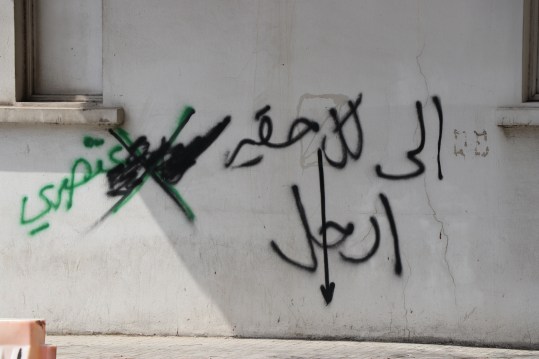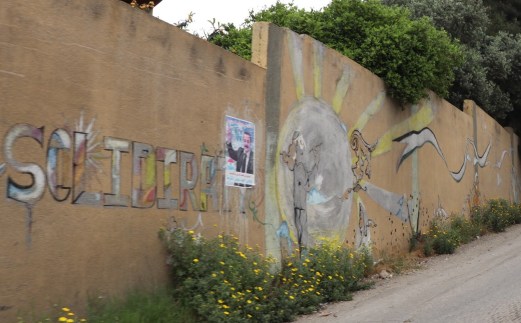By Elena Fiddian-Qasmiyeh, Refugee Hosts PI and UCL
In the run up to the Lebanese elections on 6 May 2018, national and international media and human rights organisations have denounced the appearance of anti-Syrian banners across Beirut.
Reading “The day will come when we tell the Syrians: gather your things and everything you stole, and leave,” the words on the banner below are presented as originating from the mouth of the late-Lebanese President, General Bashir Gemayel, the politician pictured to the right and named on the left of the banner.

Sadly, however, this anti-refugee discourse is perceptible both across popular and political levels, and also across policy and practice throughout Lebanon – there has been extensive documentation of the mass evictions of Syrian refugees by numerous Lebanese municipalities, for instance.
This anti-refugee politics, alongside a powerful counter-narrative to this, are also embodied in the graffiti that I recently photographed in Beirut and responded to in an earlier Refugee Hosts post (here).

In the context of the racist graffiti sprayed on the facade of this Beiruti building – which read “To every despicable Syrian, leave” – it is essential to trace the discourse and counter-discourse inscribed by, over and through the graffiti.
As seen in this photograph, the text on one side of the building was carefully altered through the use of green spray-paint, crossing-out and, where relevant, adding new text/lines.
Through this critical intervention, the original text “To every despicable Syrian, leave” became “To every despicable Syrian racist, leave” (see below), and on the other, to “To every despicable Syrian (person), leave.”

This dual process of erasure and ‘correction’ provides a rejection of the racist narrative and of racists per se.
In turn, processes of erasure and re-inscription are also perceptible when tracing the development of the banner.
The anti-Syrian words are indeed Bashir Gemayel’s, but they originally voiced a widespread rejection of the Syrian military presence in Lebanon between 1976 and 2005.
The fact that Gemayel’s words did not speak to the presence of Syrian refugees does not render the banner irrelevant to the contemporary refugee situation in Lebanon, but arguably more potent.
Indeed, the not-so-distant past, when Syrians were positioned as the unwelcome occupiers of Lebanon, continues to influence public and political opinions vis-a-vis refugees from Syria today: the rejection and racism that refugees from Syria face in Lebanon cannot be viewed outside of this recent history of animosity against Syrians.
In essence, while the words on the banner in their original iteration were anti-Syrian, they were not necessarily anti-refugee; in their current iteration they are certainly both.
Yet these words also have a longer history and invoke a broader realm of rejection and animosity. These words have, in essence, been recycled and recited in Lebanon towards many Others, before and alongside Syrians.
In particular, echoes of this rejection and expulsionary rhetoric have been repeated ad infinitum since the late-1940s, when Palestinian refugees first arrived, seeking sanctuary and protection in Lebanon.
Slogans such as “No Palestinian will remain on Lebanese soil” have been spread and sprayed on diverse spaces and surfaces throughout Lebanon’s recent history (i.e. see here).
Replacing the nationality marker ‘Palestinian’ with ‘Syrian’ may not have taken place through green spray-paint on the anti-Syrian banners, and yet the trace of this longer history of incendiary, racist and anti-refugee rhetoric remains.
As we trace the nature and implications of these exclusionary discourses, policies and practices, it is also essential to acknowledge and examine the diverse forms of local support and solidarity towards refugees which coexist alongside and indeed are enacted as powerful counter-narratives against this web of hostile popular and political rhetoric and practices towards Syrians and Palestinians alike.
It is this ongoing relationality between local communities and groups of established and ‘new’ refugees, and the relationship between diverse narratives and counter-narratives in contexts of overlapping displacement, that we continue to explore through Refugee Hosts.

*
Click here for other Refugee Hosts pieces reflecting on Representations of Displacement, and here for other pieces written by our Project PI, Dr. Elena Fiddian-Qasmiyeh.
Featured image: Graffiti sprayed on the facade of a building in Beirut, reading: “To every despicable racist, leave”. (c) E. Fiddian-Qasmiyeh, Beirut, April 2018.

11 comments